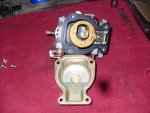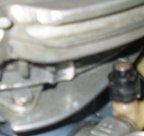Re: 1975 evinrude 9.9 fuel pump prob?
The marks on the flywheel are 180 degrees apart from each other, one for cylinder #1 (top), and #2(bottom). The timing light will illuminate only the cylinder's mark on the flywheel you have it connected to, meaning only one at a time, that way you can check and adjust each one independantly. Using a meter, or continuity tester, you hook up to the set of points (dissconnect them from the coil by unplugging the connector) and then put the flywheel on with key, but no need to put on the nut as you will be taking it on and off several times. Rotate the flywheel slowly until you notice the continuity meter indicate the points just opened (beep will quit, or if using a powered continuity light, it will go out). Note if this happens when the corresponding mark on the flywheel lines up with the fixed mark on the magneto plate. If not, move the flywheel to where the marks line up, carefully pull off the flywheel without rotaing the crank shaft, and adjust the points so the are just open as indicated by the continuity tester. This is repeated until as you rotate the flywheel, it fires on the marks. Then do this for the other cylinder. This is called static timing. Dynamic timing is checked with a strobe timing light, engine running. The strobe will reveal any changes in timing due to a worn set of points, an intermittant condensor, a worn crank top bearing, or loose magneto plate...static timing will not show that, as it cannot test for when the engine us running. With new points, set the flywheel mark to fire in the middle of the large fixed magneto plate mark, which is a tad on the retarded side, because as the point faces break in, it will advance the timing. You can re-check the timing and set it again once the engine has about 10 hours running time, as the points will be broken in by then and the timing will stabilize. I found my new points had a coating of lacquer and so I had to clean the contacts with lacquer thinner before I could get consistant readings and spark. With a car type timing light, you will need to connect it to a 12 volt battery. I have one of those old neon lights , you unplug the coil wire to the spark plug and put it inline.
About the reeds, if the timing results in an RPM increase, then leave them be. Fiber reeds need periodic changing anyway, as they take on a set after a period of time. We flip them over once, then change them the next time. You can cut some from .018" epoxy glass sheet, or if Boyesen makes a single piece reed, use it.
 , otherwise we'll be sending someone out to rip and run with that pretty lookin' Carb
, otherwise we'll be sending someone out to rip and run with that pretty lookin' Carb























